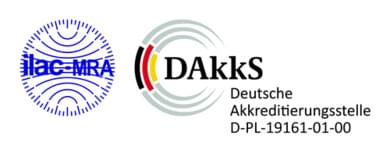
X-ray fluorescence analysis, XRF of ores and metals
Our services
- Determination of major and trace elements of oxide ores like iron ore, chromium ore, manganese ore
- Screening analysis of metals, precious metals, sulfide or metallic ore for up to 71 elements according to DIN 51418
- XRF-microanalysis, EDX for smaller samples of irregular shape
Collaborative study XRF-microanalysis of a chrome-nickel-molybdenum alloy
Additional information on X-ray fluorescence analysis of:
- ISO 29581-2:2010-03 - Cement - Test methods - Part 2: Chemical analysis by X-ray fluorescence
- DIN EN ISO 12677:2013-02 - Chemical analysis of refractory products by X-ray fluorescence (XRF) - Fused cast-bead method
- DIN EN ISO 21068-1:2008-12 - Chemical analysis of silicon-carbide-containing raw materials and refractory products - Part 1: General information and sample preparation
- DIN EN ISO 21068-2:2008-12 -Chemical analysis of silicon-carbide-containing raw materials and refractory products - Part 2: Determination of loss on ignition, total carbon, free carbon and silicon carbide, total and free silica and total and free silicon
- DIN EN ISO 26845:2008-06 - Chemical analysis of refractories - General requirements for wet chemical analysis, atomic absorption spectrometry (AAS) and inductively coupled plasma atomic emission spectrometry (ICP-AES) methods
- DIN EN 196-2:2013-10 - Method of testing cement - Part 2: Chemical analysis of cement
- DIN EN 15309:2007-08 - Characterization of waste and soil - Determination of elemental composition by X-ray fluorescence
- DIN EN 62321-3-1:2014-10 - Determination of certain substances in electrotechnical products - Part 3-1: Screening - Lead, mercury, cadmium, total chromium and total bromine by X-ray fluorescence spectrometry
- DIN 51001:2003-08 - Testing of oxidic raw materials and basic materials - General bases of work for X-ray fluorescence method (XRF)
- DIN 51001 Beiblatt 1:2010-05 - Testing of oxidic raw materials and basic materials - General bases of work for X-Ray fluorescence method (XRF) - General survey on disintegration methods referred to groups of materials for the determination of test specimens for XRF
- DIN 51081:2002-12 - Testing of oxidic raw materials and materials - Determination of change in mass on ignition
- DIN 51418-1:2008-08 - X-ray spectrometry - X-ray emission- and X-ray fluorescence analysis (XRF) - Part 1: Definitions and basic principles
- DIN 51418-2:2015-03 - X-ray spectrometry - X-ray emission and X-ray fluorescence analysis (XRF) - Part 2: Definitions and basic principles for measurements, calibration and evaluation of results
- DIN 51719:1997-07 - Testing of solid fuels - Solid mineral fuels - Determination of ash content
- DIN 51729-10:2011-04 - Testing of solid fuels - Determination of chemical composition of fuel ash - Part 10: X-Ray Fluorescence Analysis
Analytical techniques for the analysis of ores and metals by XRF
- Wide range of measurement programmes for the XRF-analysis of ores and metals from fused beads or pressed powders
- Screening analysis for up to 71 elements
- Additional tests
- Determination of bulk density and porosity
- Carbon analysis of different modifications like TOC, TIC, TC
- X-ray microanalysis, EDX to identify inclusions and impurities
Advantages of the X-ray fluorescence analysis, XRF
- accredited testing methods according to national and internationals norms
- cost efficient analyses
- short processing times
- high-precision analyses, low detection limits
- up to 71 elements during one measurement
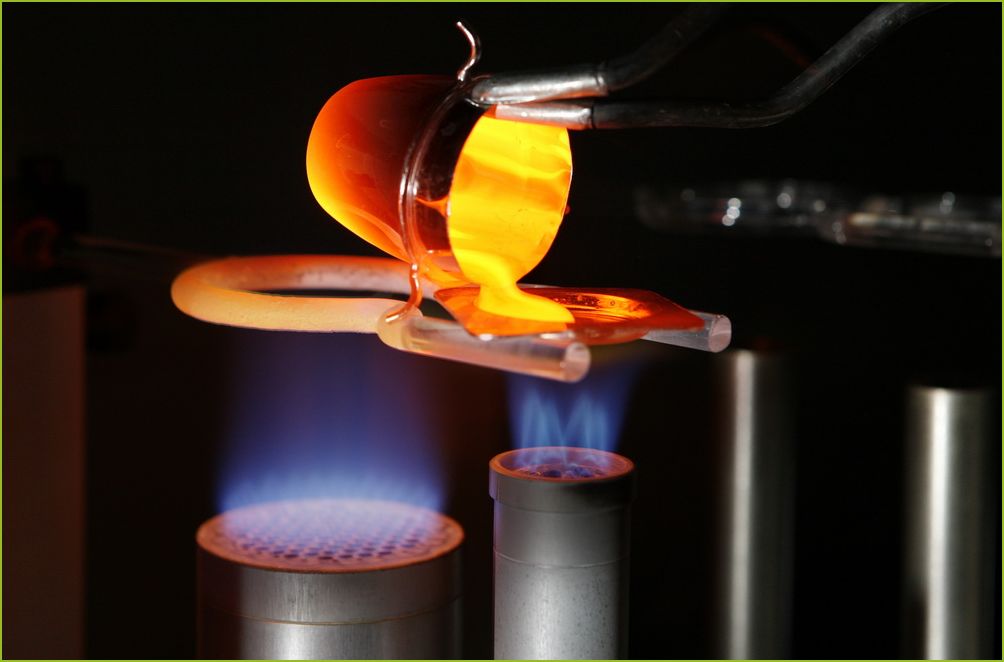 Quantitative XRF analysis from a fused bead
Quantitative XRF analysis from a fused bead
Standard analysis for 12 oxides, applicable to all materials without without Zr-rich samples
When moving the cursor over the elements highlighted in green, you will see the
- Calibration range (range) and
- the practical Limit of Detection (LOD)

|
||||||||||||||||||||||||||||||||||||||||||||||||||||||||||||||||||||||||||||||||||||||||||||||||||||||||||||||||||||||||||||||||||||||||||||||||||||||||||||||||||||||||||||||||||||
Please note:
In order to guarantee standard conformity of analysis the sample material must be ground to a grainsize < 63 µm, dried at 105°C and we need the value for the loss on ignition, LOI, as a kind of pre-preparation of the sample..
Consequently and if obligatory we carry out the sample preparation as mentioned obove - grinding, drying, determination of LOI - even though you have not explicitely ordered it.
Refer to our
► Pricelist XRF analysis
for costs and conditions.
Standard analysis for 16 oxides, applicable for Zr-rich materials with > 4 % ZrO2
When moving the cursor over the elements highlighted in green, you will see the
- Calibration range (range) and
- the practical Limit of Detection (LOD)

|
||||||||||||||||||||||||||||||||||||||||||||||||||||||||||||||||||||||||||||||||||||||||||||||||||||||||||||||||||||||||||||||||||||||||||||||||||||||||||||||||||||||||||||||||||||
Please note:
In order to guarantee standard conformity of analysis the sample material must be ground to a grainsize < 63 µm, dried at 105°C and we need the value for the loss on ignition, LOI, as a kind of pre-preparation of the sample..
Consequently and if obligatory we carry out the sample preparation as mentioned obove - grinding, drying, determination of LOI - even though you have not explicitely ordered it.
Refer to our
► Pricelist XRF analysis
for costs and conditions.
Standard analysis for 20 oxides, applicable to all materials without without Zr-rich samples
When moving the cursor over the elements highlighted in green, you will see the
- Calibration range (range) and
- the practical Limit of Detection (LOD)

|
||||||||||||||||||||||||||||||||||||||||||||||||||||||||||||||||||||||||||||||||||||||||||||||||||||||||||||||||||||||||||||||||||||||||||||||||||||||||||||||||||||||||||||||||||||
Please note:
In order to guarantee standard conformity of analysis the sample material must be ground to a grainsize < 63 µm, dried at 105°C and we need the value for the loss on ignition, LOI, as a kind of pre-preparation of the sample..
Consequently and if obligatory we carry out the sample preparation as mentioned obove - grinding, drying, determination of LOI - even though you have not explicitely ordered it.
Refer to our
► Pricelist XRF analysis
for costs and conditions.
Standard analysis for 30 elements/oxides, applicable to all materials without without Zr-, Mn, Cr-rich samples
When moving the cursor over the elements highlighted in green, you will see the
- Calibration range (range) and
- the practical Limit of Detection (LOD)

|
||||||||||||||||||||||||||||||||||||||||||||||||||||||||||||||||||||||||||||||||||||||||||||||||||||||||||||||||||||||||||||||||||||||||||||||||||||||||||||||||||||||||||||||||||||
Pleas note:
In order to guarantee standard conformity of analysis the sample material must be ground to a grainsize < 63 µm, dried at 105°C and we need the value for the loss on ignition, LOI, as a kind of pre-preparation of the sample..
Consequently and if obligatory we carry out the sample preparation as mentioned obove - grinding, drying, determination of LOI - even though you have not explicitely ordered it.
Refer to our
► Pricelist XRF analysis
for costs and conditions.
Standard analysis for 40 elements/oxides, applicable to all materials without without Zr-, Mn, Cr-rich samples
When moving the cursor over the elements highlighted in green, you will see the
- Calibration range (range) and
- the practical Limit of Detection (LOD)

|
||||||||||||||||||||||||||||||||||||||||||||||||||||||||||||||||||||||||||||||||||||||||||||||||||||||||||||||||||||||||||||||||||||||||||||||||||||||||||||||||||||||||||||||||||||
Please note:
In order to guarantee standard conformity of analysis the sample material must be ground to a grainsize < 63 µm, dried at 105°C and we need the value for the loss on ignition, LOI, as a kind of pre-preparation of the sample..
Consequently and if obligatory we carry out the sample preparation as mentioned obove - grinding, drying, determination of LOI - even though you have not explicitely ordered it.
Refer to our
► Pricelist XRF analysis
for costs and conditions.

Quantitative analysis of a fused bead for 12, 16, 20 or 40 elements according to DIN ISO 12677:2012, DIN EN 15309:2007
For the analysis of oxide and oxidizable samples composed of a wide range of different materials such as, for instance, glass and glass fibres, soils, rock, mineral raw materials, ceramic or mineral-bonded construction materials etc.
This process involves adding a flux, lithium tetra borate, to the sample material, followed by fusing in an oxidizing atmosphere after which the sample is rapidly cooled down to form a homogenous fused bead, which is then analysed with utmost precision.
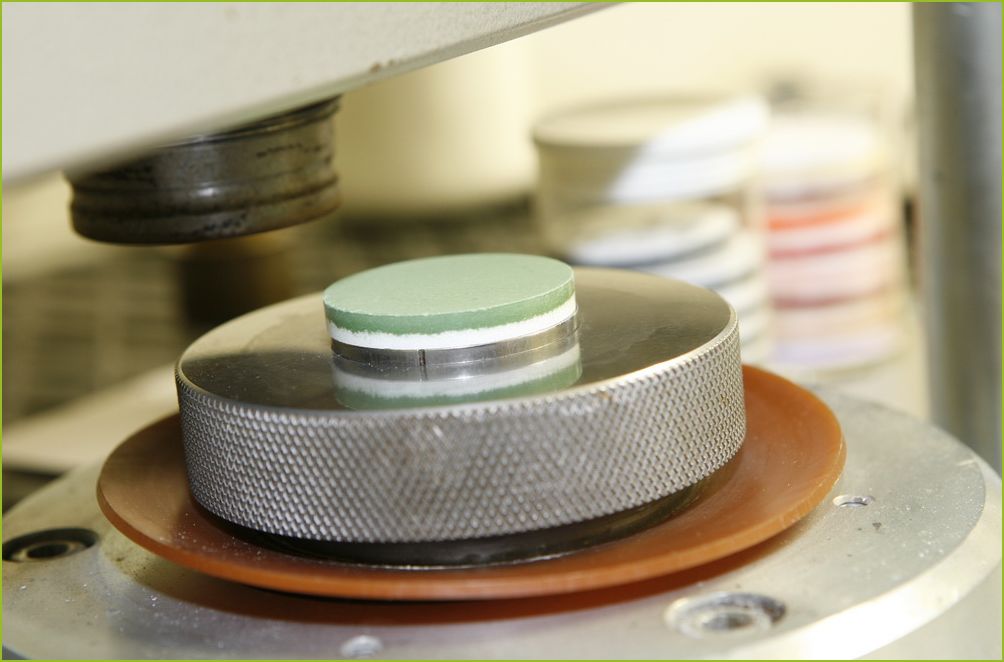 Quantitative XRF analysis from a pressed powder pellet
Quantitative XRF analysis from a pressed powder pellet
Standard analysis for 27 elements/oxides, applicable to all materials without without Zr-, Mn, Cr-rich samples
When moving the cursor over the elements highlighted in green, you will see the
- Calibration range (range) and
- the practical Limit of Detection (LOD)

|
||||||||||||||||||||||||||||||||||||||||||||||||||||||||||||||||||||||||||||||||||||||||||||||||||||||||||||||||||||||||||||||||||||||||||||||||||||||||||||||||||||||||||||||||||||
Please note:
In order to guarantee standard conformity of analysis the sample material must be ground to a grainsize < 63 µm, dried at 105°C and we need the value for the loss on ignition, LOI, as a kind of pre-preparation of the sample..
Consequently and if obligatory we carry out the sample preparation as mentioned obove - grinding, drying, determination of LOI - even though you have not explicitely ordered it.
Refer to our
► Pricelist XRF analysis
for costs and conditions.
Standard analysis for 40 elements/oxides, applicable to all materials without without Zr-, Mn, Cr-rich samples
When moving the cursor over the elements highlighted in green, you will see the
- Calibration range (range) and
- the practical Limit of Detection (LOD)

|
||||||||||||||||||||||||||||||||||||||||||||||||||||||||||||||||||||||||||||||||||||||||||||||||||||||||||||||||||||||||||||||||||||||||||||||||||||||||||||||||||||||||||||||||||||
Please note:
In order to guarantee standard conformity of analysis the sample material must be ground to a grainsize < 63 µm, dried at 105°C and we need the value for the loss on ignition, LOI, as a kind of pre-preparation of the sample..
Consequently and if obligatory we carry out the sample preparation as mentioned obove - grinding, drying, determination of LOI - even though you have not explicitely ordered it.
Refer to our
► Pricelist XRF analysis
for costs and conditions.
Standard analysis for 50 elements/oxides, applicable to all materials without without Zr-, Mn, Cr-rich samples
When moving the cursor over the elements highlighted in green, you will see the
- Calibration range (range) and
- the practical Limit of Detection (LOD)

|
||||||||||||||||||||||||||||||||||||||||||||||||||||||||||||||||||||||||||||||||||||||||||||||||||||||||||||||||||||||||||||||||||||||||||||||||||||||||||||||||||||||||||||||||||||
Please note:
In order to guarantee standard conformity of analysis the sample material must be ground to a grainsize < 63 µm, dried at 105°C and we need the value for the loss on ignition, LOI, as a kind of pre-preparation of the sample..
Consequently and if obligatory we carry out the sample preparation as mentioned obove - grinding, drying, determination of LOI - even though you have not explicitely ordered it.
Refer to our
► Pricelist XRF analysis
for costs and conditions.

Especially suitable for environmentally relevant samples such as, for instance, contaminated or non-contaminated soil, clarifier sludge, refuse incineration residues, but also FGD gypsum, fly ash and other material. Owing to the type of preparation, texture and grain size effects may cause identification errors of the light major elements with atomic numbers up to 15. As far as the evaluation of raw material is concerned at least the elements ranging from Na to Si should also be additionally analyzed by fusion.
The 27-element software program is especially suitable when dealing with problems for which a specific range of elements need to be analysed, such as the LAGA or the Kloke lists, the Sewage Sludge Ordinance, or EC Directives. In environmental toxicology, however, a large number of additional elements exist which are not considered in these lists of detection limits, standard and reference values.
If a contamination with one or more of these elements is suspected or when drawing up land cadastres, we recommend that a more comprehensive measurement programme for 40 or 50 elements be chosen.
In the above cases, the material is carefully prepared as follows: the sample is dried in a drying oven at a temperature of 40°C to prevent volatilisation losses of metallic or metal-organic mercury compounds, for example, and then ground in an agate mill, unless this has already been done before supplying the material.
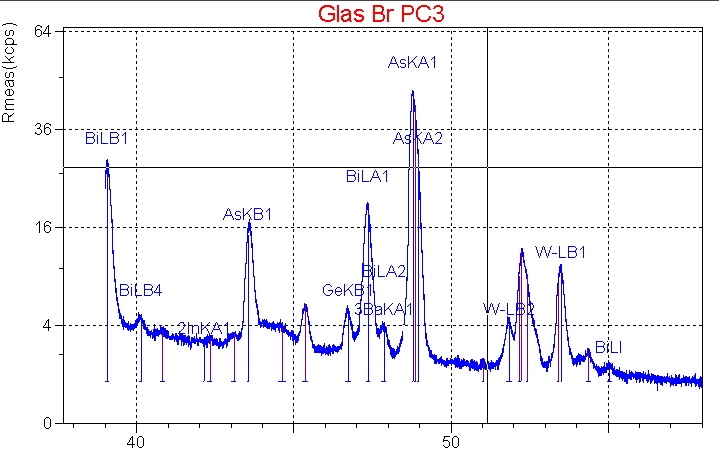 Screening analysis for 71 oxides/elements
Screening analysis for 71 oxides/elements
Screening analysis on 71 oxides/elements. Limit of detection 250 µg/g
|
||||||||||||||||||||||||||||||||||||||||||||||||||||||||||||||||||||||||||||||||||||||||||||||||||||||||||||||||||||||||||||||||||||||||||||||||||||||||||||||||||||||||||||||||||||
Please note:
In order to guarantee standard conformity of analysis the sample material must be ground to a grainsize < 63 µm, dried at 105°C and we need the value for the loss on ignition, LOI, as a kind of pre-preparation of the sample..
Consequently and if obligatory we carry out the sample preparation as mentioned obove - grinding, drying, determination of LOI - even though you have not explicitely ordered it.
Refer to our
► Pricelist XRF analysis
for costs and conditions.
 The fundamental parameter programme Omnian provides a matrix-independent, quantitative, semi-quantitative or qualitative XRF analysis of unknown samples with a variety of material properties and different organic and inorganic compositions.
The fundamental parameter programme Omnian provides a matrix-independent, quantitative, semi-quantitative or qualitative XRF analysis of unknown samples with a variety of material properties and different organic and inorganic compositions.
Samples can be analyzed either after preparation or without preparation and non-destructively in case of a suitable composition, i.e. X-ray and vacuum stable and depending on their surface condition.
This enables us to determine element concentrations between the minimum detection limit, usually 250 µg/g and 100%.

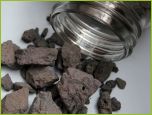 Chromium ore
Chromium ore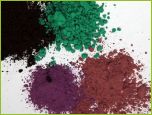 Pigments
Pigments